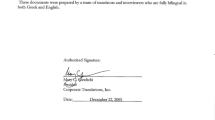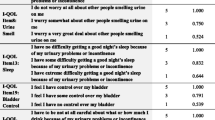Abstract
Objective: Overactive bladder (OAB) is characterized by symptoms of urinary frequency and urgency, with and without incontinence, and has been shown to have significant impact on health-related quality of life (HRQL). Currently, no OAB-specific questionnaires exist to evaluate all symptoms of OAB; thus we sought to evaluate the psychometric properties of a newly developed OAB HRQL questionnaire. Methods: The 33-item, self-administered OAB-q contains a symptom bother and HRQL scale. Both the OAB-q and SF-36 were completed by participants from two sources: (1) a community sample who screened positive for OAB in a random-digit dial telephone survey and participated in a clinical validation study (n = 254); and (2) a clinical study of patients' seeking treatment for OAB symptoms (baseline assessment) (n = 736). Item and exploratory factor analysis were performed to assess the subscale structure of the questionnaire. Psychometric evaluation was conducted to assess reliability and validity. Results: Seventy-four percent of the sample were women with mean age of 58.5. Participants with continent and incontinent symptoms reported significantly greater symptom bother and HRQL impact than normal participants. Significant differences were present among all patient groups in all OAB-q subscales (p < 0.0001) except sleep where the impact of continent and incontinent OAB was similar, but significantly worse than normal participants (p < 0.0001). Internal consistency was high with the subscale Cronbach α-values ranging from 0.86 to 0.94. Conclusion: The OAB-q is a reliable and valid instrument that discriminates between normal and clinically diagnosed continent and incontinent OAB participants. The OAB-q demonstrates that both continent and incontinent OAB symptoms cause significant symptom bother and have a negative impact on HRQL.
Similar content being viewed by others
References
Abrams P, Wein AJ. The overactive bladder and incontinence. Neurourol Urodyn 1999; 18: 413-416.
Abrams P, Cardozo L, Fall M, et al. The standardization of terminology of lower urinary tract function: Report from the standardization sub-committee of the International Continence Society. Neurourol Urodyn 2002; 21: 167-178.
Stewart W, Herzog R, Wein A, et al. on behalf of the NOBLE Program Research Team. Prevalence and impact of overactive bladder in the US: Results from the NOBLE program. Neurourol Urodyn 2001; 20 (4): Abstract 24.
Thom D. Overactive bladder: Epidemiology and impact on quality of life. Patient Care 2000; (Winter): 6-14.
Leidy NK, Revicki DA, Geneste B. Recommendations for evaluating the validity of quality of life claims for labeling and promotion. Value Health 1999; 2: 113-127.
Pleil A, Reese PR, Kelleher CJ, Okano GJ. Health-related quality of life of patients with overactive bladder receiving immediate release tolerodine. Health Econ Prev Care (HEPAC) 2001; 2: 69-75.
Brown J, Posner S, Stewart A. Urge incontinence: New health-related quality of life measure. J Am Geriatr Soc 1999; 47: 980-988.
Lubeck D, Prebil L, Peeples P, Brown J. A health-related quality of life measure for use in patients with urge urinary incontinence: A validation study. Qual Life Res 1999; 8: 337-344.
Grimby A, Milsom I, Molander U, et al. The influence of urinary incontinence on the quality of life of elderly women. Age Ageing 1993; 22: 82-89.
Hunskaar S, Vinsnes A. The quality of life in women with urinary incontinence as measured by the sickness impact profile. J Am Geriatr Soc 1991; 39: 378-382.
Kobelt G, Kirchberger I, Malone-Lee J. Quality-of-life aspects of the overactive bladder and the effect of treatment with tolterodine. BJU Int 1998; 83: 583-590.
O'Conor R, Johannesson M, Hass S, Kobelt-Nguyen G. Urge incontinence: Quality of life and patients' valuation of symptom reduction. Pharmacoeconomics 1998; 14(5): 531-539.
Wyman J, Harkins S, Choi S, Taylor J, Fantl A. Psychosocial impact of urinary incontinence in women. Obstet Gynecol 1987; 70: 378-381.
Jolleys JV, Donovan JL, Nanchahal K, Peters TJ, Abrams P. Urinary symptoms in the community: How bothersome are they? Br J Urol 1994; 74: 551-555.
Jackson S, Donovan J, Brookes S, Eckford L, Swithinbank L, Abrams P. The Bristol female lower urinary tract symptoms questionnaire: Development and psychometric testing. Br J Urol 1996; 77: 805-812.
Kelleher CJ, Cardozo LD, Khullar V, Salvatore S. A new questionnaire to assess the quality of life of urinary incontinent women. Br J Obstet Gynaecol 1997; 104: 1374-1397.
Lee P, Reid D, Saltmarche A, Linton L. Measuring the psychosocial impact of urinary incontinence: The York incontinence perceptions scale (YIPS). J Am Geriatr Soc 1995; 43: 1275-1278.
Shumaker S, Wyman JF, Uebersax JS, McClish D, Fantl JA. Health-related quality of life measures for women with urinary incontinence: The incontinence impact questionnaire and the urogenital distress inventory. Qual Life Res 1994; 3: 291-306.
Wagner TH, Patrick DL, Bavendam TB, Martin ML, Buesching DP. Quality of life of persons with urinary incontinence: Development of a new measure. Urology 1996; 47(1): 67-72.
DuBeau C, Kiely D, Resnick N. Quality of life impact of urge incontinence in older persons: A new measure and conceptual structure. J Am Geriatr Soc 1999; 47: 989-994.
Norton PA, MacDonald LD, Sedgwick PM, Stanton SL. Distress and delay associated with urinary incontinence, frequency, and urgency in women. BMJ 1998; 297: 1187-1189.
Robinson D, Pearce K, Preisser J, Dugan E, Suggs P, Cohen S. Relationship between patient reports of urinary incontinence symptoms and quality of life measures. Obstet Gynecol 1998; 91: 224-228.
Liberman JN, Hunt TL, Stewart WF, et al. Health-related quality-of-life among adults with symptoms of overactive bladder: Results from a US community-based survey. Urology 2001; 57(6): 1044-1050.
Coyne K, Schmier J, Hunt T, Corey R, Liberman J, Revicki D. Developing a specific HRQL instrument for overactive bladder. Value Health 2000; 3: 141.
Ware JE, Snow KK, Kosinski M, Gandek B. SF-36 Health survey manual and interpretation guide. Boston: New England Medical Center, The Health Institute, 1993.
Hays RD, Stewart AL. Sleep measures. In: Stewart AL, Ware JE Jr (eds), Measuring Functioning and Well-being: The Medical Outcomes Study Approach. Durham, NC: Duke University Press, 1992; 235-259.
Harati Y, Gooch C, Swenson M, et al. Double-blind randomized trial of tramadol for the treatment of the pain of diabetic neuropathy. Neurology 1998; 50: 1842-1846.
Payne R, Mathias SD, Pasta DJ, Wanke LA, Williams R, Mahmoud R. Quality of life and cancer pain: Satisfaction and side effects with transdermal fentanyl versus oral morphine. J Clin Oncol 1998; 16: 1588-1593.
Radloff LS. The CES-D scale: A self-report depression scale for research in the general population. Appl Psychol Meas 1977; 1: 385-401.
Radloff LS, Teri L. Use of the center for epidemiological studies-depression scale with older adults. Clin Gerontol 1986; 5: 119-136.
Hays RD, Hayashi T. Beyond internal consistency reliability: Rationale and user's guide for Multitrait Analysis program on the microcomputer. Behav Res Meth Instr Comp 1990; 22: 167-175.
Mulaik SA. The foundations of factor analysis. New York: McGraw-Hill, 1972.
Cronbach LJ. Coefficient alpha and the internal structure of tests. Psychometrika 1951; 16: 297-334.
Donovan J. Measuring the impact of nocturia on quality of life. BJU Int 1999; 84: 21-25.
Revicki DA, Osoba D, Fairclough D, et al. Recommendations on health-related quality of life research to support labeling and promotional claims in the United States. Qual Life Res 2000; 9: 887-900.
Author information
Authors and Affiliations
Corresponding author
Rights and permissions
About this article
Cite this article
Coyne, K., Revicki, D., Hunt, T. et al. Psychometric validation of an overactive bladder symptom and health-related quality of life questionnaire: The OAB-q. Qual Life Res 11, 563–574 (2002). https://doi.org/10.1023/A:1016370925601
Issue Date:
DOI: https://doi.org/10.1023/A:1016370925601




